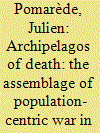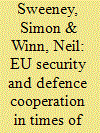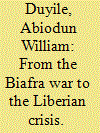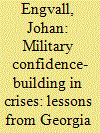| Srl | Item |
| 1 |
ID:
173159


|
|
|
|
|
| Publication |
Delhi.
|
| Summary/Abstract |
How is the notion of success rearticulated in the contemporary context of endless counterinsurgencies (COIN)? To answer, the paper engages the thesis that the recent COIN campaigns were founded on a dysfunctional disconnect between the “hearts and minds” principles and the reality of the indefinite use of force. I show that this tension (called the “tactical trap”) is not a pathology of COIN, but one of its productive sites. The tactical trap is an assemblage of violence that brings together the endless use of force and the population-centric narrative through the principle of futurity, i.e. an indeterminate horizon of “progress.” Taking inspiration from the Critical War Studies and the Afghan warfare as a case study, I highlight the paradoxical nature of population-centric war: it is founded on a violence that makes COIN both a permanent state of failure and a probable success. The indeterminacy of violence is then analyzed as a new ordering of risk-management warfare, based on the everyday (re)invention of the potentiality of “progress.”
|
|
|
|
|
|
|
|
|
|
|
|
|
|
|
|
| 2 |
ID:
173158


|
|
|
|
|
| Summary/Abstract |
There is an extensive and rapidly growing body of literature on armed Unmanned Combat Aerial Vehicles (UCAVs) focused on the US War on Terror. However, smaller Unmanned Aerial Vehicles for military use, or what this paper refers to as tactical UAVs utilised by small states, have received much less scholarly attention ̶ despite their rapid proliferation in the last decade. In order to start rectifying this dual neglect of more limited UAVs employed by small states, the paper makes an empirical contribution to the study of tactical UAVs. Drawing on a substantial number of interviews and studies commissioned by the Swedish Armed Forces, the paper examines the Swedish UAV program, which is in certain ways representative of a smaller state’s efforts to incorporate UAVs into its armed forces. The paper argues that it is crucial to think in terms of systems rather than the UAV as a free-standing resource to be used on its own. If utilized along with other ISR assets, tactical UAVs may have a significant role to play in asymmetric conflicts.
|
|
|
|
|
|
|
|
|
|
|
|
|
|
|
|
| 3 |
ID:
173160


|
|
|
|
|
| Summary/Abstract |
Has the United Kingdom(UK) Brexit referendum been a catalyst for more European Union security cooperation? How significant are post-referendum initiatives in security and defence? What are the implications of Brexit for European Union (EU) and UK security and defence? This article analyses EU post-Brexit strategic choices following the launch of the EU Global Strategy (2016). EU autonomy in security and defence requires close cooperation with third countries, including Norway and post-Brexit UK. It remains to be seen whether the EU and the UK can forge a new bespoke security and defence relationship that delivers mutual benefits through shared strategic ambitions, while also protecting their various interests. We suggest there will be serious collateral damage to UK-EU security and defence cooperation if post-Brexit trade negotiations descend into acrimony and mistrust, especially in the event of “no-deal” once the “transition period” ends. This would undermine European security and the EU’s quest for strategic autonomy in world affairs and have serious implications for both UK and EU security. We conclude that the EU needs to work with the UK on a plan to achieve global strategic autonomy, or both risk reduced influence in the wider world in the years ahead.
|
|
|
|
|
|
|
|
|
|
|
|
|
|
|
|
| 4 |
ID:
173162


|
|
|
|
|
| Summary/Abstract |
The sea has increased in importance as a source of useful resources. The nation that has control of its immediate and external seas is in a good position to choose how much or how little of sea resources it wants. It is the importance of the sea and the sea lines of communication to nations that has made thoughts such as maritime power, sea power, naval strategy … etc significant to them. The paper also examined the naval and constabulary relevance of the Nigerian Navy to its maritime environment. The study relied on primary and documentary data. The documentary data were sourced from books, newspapers and annual reports. The secondary sources used were subjected to textual and contextual evaluations. The primary sources was basically interviews with some important actors in the era. The paper’s study of the Nigerian Navy also identified the roles of a small navy and their importance to the maritime environment.
|
|
|
|
|
|
|
|
|
|
|
|
|
|
|
|
| 5 |
ID:
173161


|
|
|
|
|
| Summary/Abstract |
What role can conventional arms control (CAC) and confidence- and security-building measures (CSBMs) play in crises and conflicts? By examining the use of CAC and CSBMs during the Russian-Georgian war in 2008 and during Russia’s annexation of Crimea and the war in eastern Ukraine in 2014, the present article argue that CAC and CSBMs are unable to prevent intentional conflict. Their more realistic value in crises is to function as early warning mechanisms that raise the bar for and increase the costs of conflict as well as serving as instruments to monitor conflicts. To increase their effectiveness, the links between early warning and early action need strengthening and several ambiguities need to be removed, particularly form the Vienna Document, in order to improve indicators, increase warning times and raise the political costs of non-compliance. Nonetheless, when one or two sides seek a conflict, CAC and CSBMs do not provide a remedy for conflict prevention.
|
|
|
|
|
|
|
|
|
|
|
|
|
|
|
|